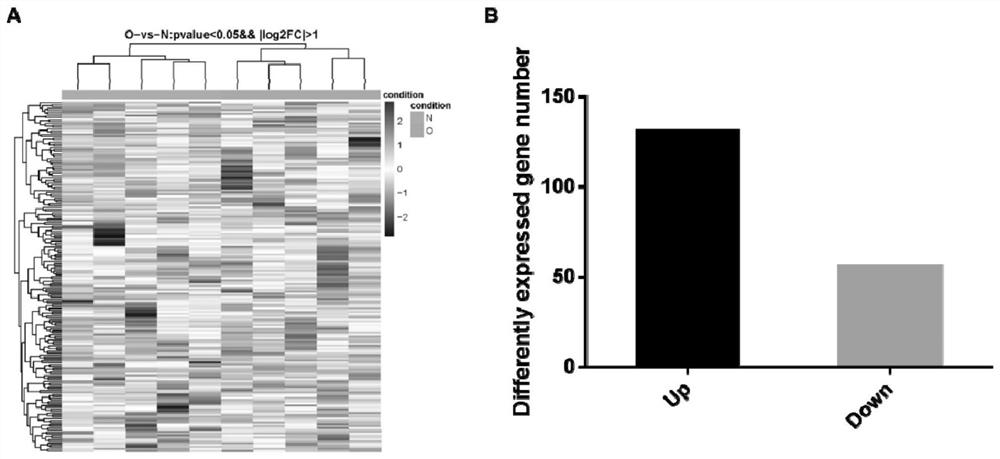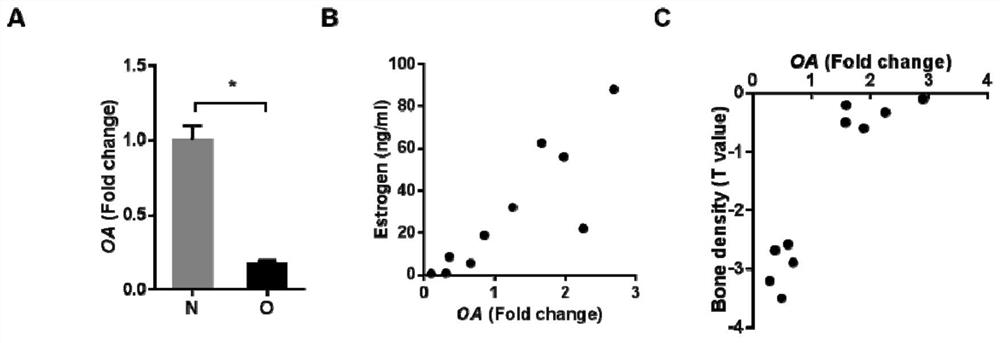Biomarker OA (osteoactivin) for detecting postmenopausal osteoporosis and kit of biomarker OA
An osteoporosis and biomarker technology, applied in the field of bioengineering, can solve the problems of women's physical harm and complex methods, and achieve the effect of avoiding radiation, obvious technical effect, high clinical application value and prospect.
- Summary
- Abstract
- Description
- Claims
- Application Information
AI Technical Summary
Problems solved by technology
Method used
Image
Examples
Embodiment 1
[0024] In order to study the pathogenesis of postmenopausal osteoporosis, the present invention selects postmenopausal female patients hospitalized for fractures in the Department of Orthopedics, Gongli Hospital, Pudong New District, Shanghai, and performs Lunar Prodigy dual-energy X-ray absorptiometry (GE Company of the United States) for detection. And according to the bone density T value, they were divided into normal bone mass group (N) (T>-1) and osteoporosis group (O) (T<-2.5), with 5 people in each group. (This patent application has been approved by the Hospital Ethics Committee)
[0025] The patient's peripheral blood sample was taken, and the white blood cells were separated to extract RNA, and the whole transcriptome sequencing (RNA-Seq) was performed (performed by Shanghai Ouyi Biomedical Technology Co., Ltd.). The results showed that compared with the normal bone mass group, there were 187 mRNAs with statistically significant expression differences of more than 2...
Embodiment 2
[0028] In view of the important regulatory effect of free CD14+ monocytes in peripheral blood on the differentiation of osteoclast precursor cells to bone metabolism, the present invention selects postmenopausal women with normal bone mass and osteoporosis, extracts peripheral blood samples, and uses Ficoll density Gradient centrifugation was used to separate and obtain peripheral blood mononuclear cells (PBMC), and further immunomagnetic bead sorting was used to obtain CD14 + Monocytes; OCP in vitro TM BulletKit TM After culture and expansion in special medium for osteoclast precursor cells, RNA and protein were extracted and detected by qRT-PCR, Western blot and flow cytometry. The results showed that peripheral blood CD14 in postmenopausal women with osteoporosis + monocyte OA mRNA ( image 3 A) and protein ( image 3 B, C) The expression levels were significantly decreased.
Embodiment 3
[0030] To make mice OVX osteoporosis group and sham operation (Sham) group model, MicroCT ( Figure 4 A) and HE staining ( Figure 4 B) Verify that the modeling was successful. Flow cytometry analysis showed that CD14 + The expression level of OA protein in monocytes decreased significantly ( Figure 5 A and 5B).
[0031] Example 3
[0032] When the level of estrogen decreases, OA negatively regulates the function of Th17 cells and inhibits the abnormal activation of osteoclasts, which plays an important regulatory role in postmenopausal osteoporosis.
[0033] Studies have shown that: first, under in vitro induced differentiation conditions, low expression of OA can promote CD14 + Monocytes differentiate into osteoclasts ( Figure 6 , 7 );
[0034] Sorted osteoporosis group (O) peripheral blood CD14 + Monocytes were induced by adding RANKL (30 ng / ml) and M-CSF (30 ng / ml) in vitro, and the number of TRAP-positive cells was found ( Figure 6 A) and bone resorption area...
PUM
 Login to View More
Login to View More Abstract
Description
Claims
Application Information
 Login to View More
Login to View More - R&D
- Intellectual Property
- Life Sciences
- Materials
- Tech Scout
- Unparalleled Data Quality
- Higher Quality Content
- 60% Fewer Hallucinations
Browse by: Latest US Patents, China's latest patents, Technical Efficacy Thesaurus, Application Domain, Technology Topic, Popular Technical Reports.
© 2025 PatSnap. All rights reserved.Legal|Privacy policy|Modern Slavery Act Transparency Statement|Sitemap|About US| Contact US: help@patsnap.com



